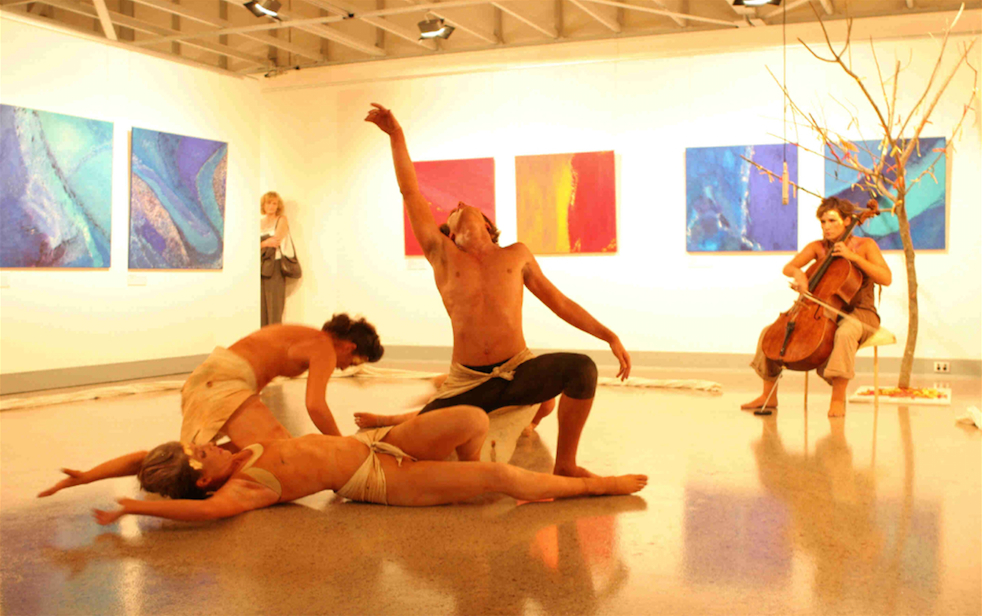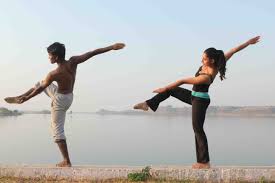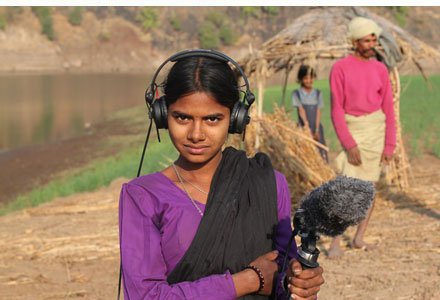My creative interest in rivers manifested in early environmentally engaged instrumental compositions such as River of Mirrors (2004), composed for chamber orchestra and inspired by elements of the Noosa Everglades. This work used an array of extended performance techniques to imitate the natural soundscapes, and employed repetitive textures to evoke the tannin-stained, mirrored waterways of Noosa River. The following year, in 2005, I composed Confluence, my first major multimedia environmental work commissioned for the opening of Earth Song Exhibition, during the launch of the Queensland Great Walks. Although not inspired by a specific river, Confluence drew inspiration from the characteristics of water and rivers and used hydrophone recordings as compositional source material. The piece was composed for cello, live electronics, digital projections and two dancers, which created an immersive environment in a constant state of change that was controlled live. These two projects informed the development of my largest rivers project Sound Mirrors, and the beginning of a large-body of work inspired by rivers over the last ten years.

Sound Mirrors is an interactive sound installation that responds to specific rivers across the world. During 2009 and 2010 I travelled through Australia, India, Korea, and China, capturing the sound of significant rivers and their surrounding communities. Sound Mirrors grew out of my lifelong connection with rivers and a deep affinity with water. I was inspired to explore a voice for the rivers through electroacoustic composition at a time when I felt it was becoming very important to listen to the environment.
My creative inspiration from rivers is shared by a wide spectrum of electroacoustic composers who have created works inspired by rivers across the world. Among the most pertinent is Voicing the Murray, an immersive sound installation by pioneering Australian composer Ros Bandt. The work was commissioned for the Mildura Arts Festival, and was designed to give the Murray River a voice: ‘A voice derived from all the voices impinging on its banks and surfaces’ (Bandt, 1996).
Bandt’s composition process involved several on-site recording sessions, which focused on gathering stories from the local people. She was interested in the idea of capturing endangered sounds and exploring how the soundscape of the area had changed and evolved with the impact of technology. The project was underpinned by environmental intentions; Bandt wanted to draw attention to the environmental degradation of the area, by encouraging listeners to engage in the rich soundscapes:
“I was excited at the prospect, as the Murray River is such a unique and critical habitat for the whole of Australia. It is a manmade oasis which has brought with it the by-products of man’s overuse of the environment, erosion, salination, and cultural dislocation for indigenous peoples.” (Bandt, 1986)
The electroacoustic repertoire inspired by rivers can be divided into three relatively distinct categories: works composed in the studio inspired by rivers; works drawing on environmental field recordings from rivers; and, finally, site-specific works that involve interactivity and community engagement. The first category includes iconic electroacoustic composers such as Richard Lainhart’s The Course of the River (1975), Douglas Lilburn’s Soundscape with Lake and River (1979), and Kaija Saariaho’s Trois Rivières (1994).
Italian composer David Monacchi’s electroacoustic composition Stati d’Acqua (States of Water) composed in 2006 is a most effective sonic exploration of a river. Those fortunate to experience a live performance of the work are immersed in multichannel sound diffusion that draws the listener deep into a dense sound world that at times evokes the sensation of being underwater. The work was inspired by the multiple physical transformations of water (such as evaporation and condensation) through processed field-recordings. The composition draws on field-research in Rome on the Tiber River, ranging from its springs in the Monte Fumaiolo to its outlet in the Tyrrhenian Sea. Monacchi explored many recording techniques, including an array of microphones and movements along various sound sources, such as springs, streams, waterfalls and caves (Monacchi, 2006). The final composition is presented as a 30-minute performance on a multichannel sound array with 18 loudspeakers.
Garth Paine’s composition Present in the Landscape (2011) is among the most pertinent of compositions that explores contentious environmental issues through immersive river soundscapes. This work was composed during a residency at Bundanon in New South Wales, Australia, and is an exploration of the nearby Shoalhaven River.
“Present in the Landscape specifically addresses the existence of a river, which runs across floodplains, and has had a dynamic and active life, changing direction, remapping its own presence in the landscape over centuries, as large weather events have occurred. However, a decade ago the large Tallowa dam was constructed upstream from the Bundanon property with the intention of providing drinking water to the communities on the south coast of New South Wales.” (Paine, 2011)

The damming of Shoalhaven completely transformed the river and had a profoundly negative effective on the local environment, as is apparent in the damming of many rivers worldwide. Paine spent time interviewing the community surrounding the river to capture local perspectives. This included Aboriginal men who offered a critical understanding of the river from the perspective of traditional owners. His ambisonic field recordings captured the environmental soundscapes of the river, from the jumping fish to the temporal flow of the landscape itself (Paine, 2011). Present in the Landscape was presented as a six-channel composition and has also been published as a stereo recording.
The diverse literature inspired by rivers is impossible to capture in a short article, but this collection of works would not be complete without mention of Annea Lockwood’s trilogy of river sound maps. The trilogy begins with A Sound Map of the Hudson River (1982), and is followed by A Sound Map of the Danube (2005) and A Sound Map of the Housatonic River (2010). Lockwood has experimented with river soundscapes from the mid-60s, but the sound maps solidified her process of creating an ‘aural tracing’ (Lockwood, 2010) and of documenting the entire length of the river through sound. The sound maps are realised as multichannel installations with the recorded sites located on a wall map accompanied by a time-code so the listener can locate the current soundscape at any given time. Lockwood’s sound maps are certainly rich creative responses to the rivers, and they are also functional and accessible insights into their respective acoustic ecologies.
The Noosa River positioned in a UNESCO listed Biosphere of Australia, the historic Han River flowing through the city of Seoul, South Korea, and the Pamba River in the evocative backwaters of Kerala, South India, formed the foundation of my Sound Mirrors project. The process was mirrored at each river involving three distinctive stages: on-site research, field recording and composition. Each of the stages involved various elements specific to that environment, such as community interviews and intensive study and collaborative performances. The process of working with the three specific rivers in Australia, Korea, and India was completed over the duration of three months, working in cultural immersion in each location. In addition to the three rivers, Sound Mirrors involved shorter duration projects on the Huangpu River in Shanghai, China, and the Pearl River Delta in Hong Kong. The realisation of Sound Mirrors was just as much about the cultural immersion in the rivers’ communities as it was about the creative process.
The process in the field varied from sculpting and layering sounds recorded on location to directly responding to the environment. The source materials range from hydrophone recordings deep in the Noosa River, to pilgrims chanting at dusk on the banks of the Pamba in South India. I worked intuitively with these materials in each location and attempted to capture a living aspect of culture through focusing on various sound marks of the environment. This project was produced on the road — in makeshift studios on boats, trains, riverbanks, and in hotel rooms — while drawing further inspiration from the environment. Working in the cultural context provided insight into the layers of tradition that were impossible to access without first-hand experience. Although these rich webs of history and heritage raised issues of possible cultural appropriation, every effort was made to approach this material in a culturally sensitive way. The most critical process was gathering permission from the appropriate custodians and building strong relationships with the rivers’ communities. By producing these works on location, as opposed to returning to the studio, I was able to gain feedback from the local community and collaborators, which was invaluable for my research process.
The Sound Mirrors installation has been exhibited a number of times, including the Noosa Regional Gallery in Australia, the Gallery of Modern Art in Bangalore, India, Stellenbosch University in South Africa and Siva Zona Contemporary Art Space in Croatia. Eleven of the resulting compositions were released as an album, titled Transient Landscapes, and these works have also been programmed at various conferences and festivals. I also began performing Transient Landscapes as a live work where I create a multi-channel mix of the river soundscapes in real-time in response to the performance location. This project has no doubt brought attention to the soundscapes of rivers, yet it is unlikely to have made any significant contribution to the conservation of river systems. While it was a positive learning curve, I recognised the potential for creative projects to have a wider impact when combined with ongoing community engagement, interdisciplinary collaborations and multi-platform outcomes. Sound Mirrors was a starting point for these ideas, and laid the foundation for River Listening.
One of the most critical outcome of Sound Mirrors was realising the opportunities for using hydrophone recordings as a measure for river health. While I could never predict exactly what the river would sound like when I lowered the hydrophones into the water, the resulting recordings were always extremely revealing about the overall health of the river.

This became even more apparent in my next large river venture, The DAM(N) Project, a large-scale interdisciplinary art project that connects Australian and Indian communities around the common concern of global water security. The project is focused on community capacity building and the creation of multi-platform creative content that can be disseminated internationally. The outcomes present the lives of remote communities in the Narmada Valley of North India, which were displaced by large-scale dam development securing hydropower for Indian cities.
As with all of my creative explorations of rivers, hydrophone field recordings have become an integral element to my practice. I am always eager to hear beneath the surface of the river, as the soundscapes reveal so many qualities, including the active marine life. Unfortunately, during our first field trip I found the hydrophone recordings in the Narmada River featured very little marine interaction, similar to the stagnant and lifeless bodies of water in the Narmada villages that were virtually silent. I was reminded of a quote from Bawabhai, an Adivasi (Indigenous) from the village of Jalsindhi in the Narmada Valley. He said the river had been silenced by the dam and lost its cleaning function, which had led to illness in the community. “Narmada used to be a narrow, melodious river, where we could walk down through the forests to its edge. Earlier the river was melodious — now it has become a silent river”. The stagnant water now carried countless viruses and diseases, which have resulted in many people fearing the water rather than worshipping it. It is inspiring to find someone that thinks about the river in sound, yet tragic to see the cultural and spiritual ramifications of damming a river for local Adivasi communities.
While the pure hydrophone recordings provided limited source material, the soundscapes with human interaction recorded from a boat were quite compelling. The sound of people washing dishes and clothes on the riverbank, splashes as people climbed into the boat and the creaking panels of the wooden vessel as we ventured down the river. The unpredictable recordings of the hydrophone abruptly dragging along the riverbed from our moving boat are not the most pleasing auditory experiences, but they captured some of the dystopian energy of this landscape. While this is perceived as a distorted sound, and something I would probably delete in other circumstances, I was compelled to make use of this recording in the project.

The other memorable field recordings were from the Jobat dam, one of the larger dams that submerged 1216 hectares across 13 villages, allegedly displacing 595 families. The metal steps along the dam wall acted like resonators propelling my footsteps along the bridge. I was struck by the silence of the dam and the intensity of my presence amplified in the soundscape. In situations where the hydrophone recordings provide limited source material, I compose based on my response to the landscape. In this example you can hear the Jobat dam recordings and the propeller of our small boat travelling down the river.
As rivers across the world continue to be impacted by human activity, the River Listening project is designed to extend on the existing creative work I have done in this area to explore a process that could bring attention to rivers as ecological entities that deserve respect and conservation. River Listening is deeply grounded in the scientific possibilities of hydrophone recording and the role of community engagement and multi-platform presentations. The process involves not just composing (in the traditional sense of the word) but collaborating with the community, listening to each river, and, at each site, responding and adapting to other processes that may emerge.

References
Barclay, L. (2013). Sonic Ecologies: Exploring the Agency of Soundscapes in Ecological Crisis. Soundscape The Journal of Acoustic Ecology, 12(1), 2013, 29 ‐32.
Bandt, R. (1996). Voicing the Murray. Retrieved from http://www.sounddesign.unimelb.edu.au/web/biogs/P000352b.htm
Krause, B. (2012). The great animal orchestra. New York: Little, Brown and Company.
Lainhart, R. (1975). The Course of the River. [LP]. USA: Vicmod records.
Lilburn, D. (2004). Complete Electro-Acoustic Works. [CD]. New Zealand: Atoll.
Lockwood, A. (1989). A Sound Map of the Hudson River. [CD]. USA: Lovely Music.
Lockwood, A. (2004). Sound mapping the Danube River from the Black Forest to the Black Sea: Progress report, 2001–2003. Soundscape, The Journal of Acoustic Ecology 5(1), 32–4.
Lockwood, A. (2007). What is a river. Soundscape: The Journal of Acoustic Ecology, 7(1), 43–4.
Lockwood, A. (2008). A Sound Map of the Danube. [CD]. USA: Lovely Music.
Lockwood, A. (2010). A Sound Map of the Housatonic River. Retrieved from http://www.annealockwood.com/compositions/housatonic.htm
Marshall, A. (2002) The Unity of Nature: Wholeness and Disintegration in Ecology and Science. London: Imperial College Press.
Monacchi, D. (2006). Stati d’Acqua: Eco-acoustic compositions. [CD]. New York: Electronic Music Foundation Ltd.
Paine, G. (2011). Present in the landscape. Retrieved from http://www.eartotheearth.org/artistswork/paine_110506.html
Saariaho, K. (2002). Six japanese gardens & Trois Rivières Delta. [CD]. Paris: INA-GRM.